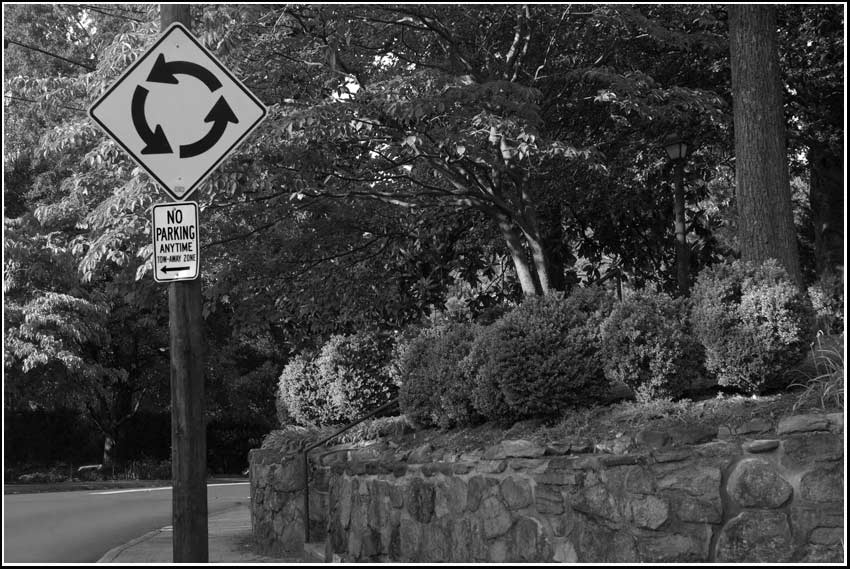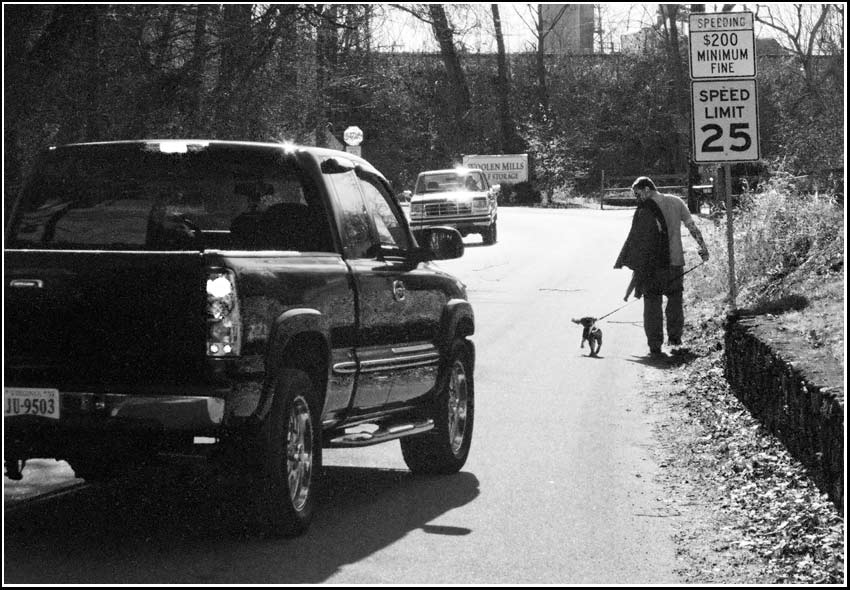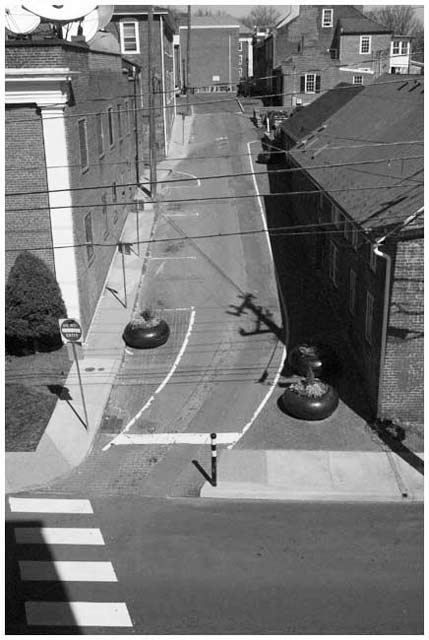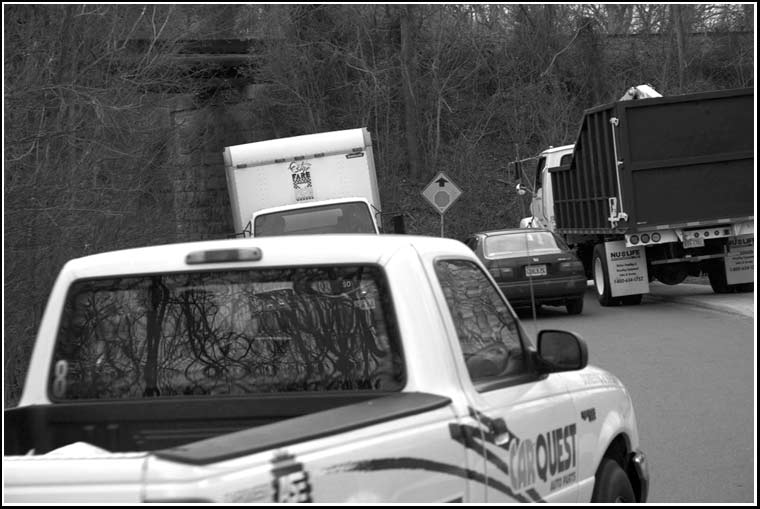
Picnic tables under Interstate 610. Yes, there is good shade under the bridge. But, it is mighty noisy and the automobile dust raining down doesn’t improve the taste of sandwiches. What were the planners thinking?
Maybe we can do this in Charlottesville in our park after we build a road through it, a picnic area for trolls?
Category: traffic
Envy

I have envy. One of the dread Capital Vices, a.k.a. the seven deadly sins.
Traffic control envy.
Everyday I bike through the 2nd Street Northwood corridor of Charlottesville . This is a lovely neighborhood with many traffic calming measures, excellent pedestrian facilities and little cut-through traffic. This neighborhood is eminently walkable. From the sign above, It looks like they are fixing to get roundabouts? Good idea…
My envy, my argument on this subject is one of need and equity. Lets use geospatial technology to see where our City spends its capital improvement dollars and help direct the allocation of those funds. GPS analysis might help us combat the “two Charlottesvilles” problem. When we spend money to address quality of life, traffic and safety issues we should strive for even handedness. I think the CIP/GPS overview would produce revelatory results.
A year ago I posted a video of a street I walk every day, Franklin Street. Franklin has no sidewalk. 75% of Franklin’s motorists are short-cutting through residential neighborhoods (Belmont and Woolen Mills) to save time. This is an issue raised with the City over twenty years ago. Remedial action has been proposed in the next five years.
What is the city but the people?–Shakespeare

I walk a lot, When home I walk this section of road everyday. My neighbor Roy (pictured here)
recalls driving his aunt Emma Amiss‘ dairy cow from her house on Woolen Mills Road
to the pasture on the south side of the railroad tracks via this lane.
Nowadays, this isn’t an easy or safe path because of traffic short-cutting
through the neighborhood. Back then, Roy remembers the cow herding as challenging,
this was a dog-trot, a rustic footpath with stones in the way.
Tonight, the Charlottesville Planning Commission and City Council have a scheduled
joint public hearing on how to prioritize pedestrian facilities.
From an urban planning perspective there have long been guidelines to direct these City improvements, there are over fifty mentions of sidewalks in
Charlottesville’s Comprehensive Plan (a few are listed here).
So which pedestrians are blessed? We like pedestrians, but some more than others.
And when it’s a question of cars versus pedestrians, for whom do we provide?
The street above, Franklin, is a neighborhood street, carrying around 1600 vehicles per day.
Of those vehicles, 74% are not local traffic, traffic arising from the neighborhoods on
either side of the railroad tracks, they are from elsewhere.
They are piloted by Outlanders cutting through, using neighborhood streets to
avoid the pesky street lights on the arterial streets and collector roads.
If Franklin passed through nice neighborhoods it is likely that these issues
(pedestrian safety and cut-through) would have been addressed long ago.
What do I mean by nice neighborhoods? Neighborhoods with some money.
Glance at the street in the photo below, it is in the tourist section of town,
not a CDBG neighborhood, lawyers carry briefcases instead of kids toting fishing poles.
The street below was made one way. It has pedestrian provisions on both sides of the street.
No danger of being run over by a potato-chip or a shit-hauling truck on that street.

When cities address capital improvement investment, where does the money go?
There is an amazing map technology, GIS, that some localities employ.
With the input of data, one could see the geographical correlation between say,
the dollars spent on capital improvement in a region of the city and the financial
clout of residents in that part of the city.
Are our parks, pedestrian facilities and municipal improvements as accessible
to the poor as to the rich?

The process proposed for discussion tonight before our planning commissioners
and elected officials suggests creating a sidewalk list every five years.
Rather than keeping a permanent list, in the sunlight of the Internet,
a permanent list that records when projects were logged on and completed,
a transitory list is proposed.
Thankfully, there was deep thinking on the priorities for the first iteration of this process,
whose needs are to be addressed, poor folks might git somewhere to walk.
What I don’t like is the ephemeral nature of a five year list:
Is there any way to remedy how to include additional citizen requests in a
systematic way? One purpose in creating a new list is to limit it to the amount
that can be built within a 5 year period (in lieu of the 1997 list of 99 projects) so
that citizens can reasonably expect their next opportunity for adding new
projects. Interested persons could submit a request at any time during the 5-year
time frame, the submittal to be kept in a file, and all then evaluated once the next
review cycle approaches.–staff memo
Suppose the Franklin Street Walkers are amongst the chosen, and the sidewalk in their
neighborhoods is slated for construction in the next five years. Oops! but the
sidewalk doesn’t get built. What then? It will be reevaluated, possibly with new criteria,
when the next review cycle comes along? The scheduled project will be unscheduled
and possibly blessed once more?
It’s a smart process, akin to a filing cabinet that every five years
transmogrifies into an incinerator.
Kicking the can down the road. We know how this game gets played. We beg, we plead, we excoriate. And sometimes, change happens.